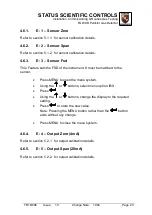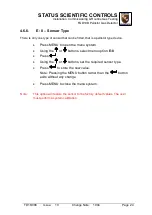
STATUS SCIENTIFIC CONTROLS
Installation, Commissioning & Routine Gas Testing
FGD10B Pellistor Gas Detector
TD18/008
Issue:
10
Change Note:
1904
Page 9
3.
I
NSTALLATION
It is important that the correct cable and gland types are used when installing
the FGD10B in a hazardous location.
The cable entry devices and blanking elements of unused apertures shall be
of a certified flameproof type, suitable for the conditions of use and correctly
installed.
With the use of conduit, a suitable certified sealing device such as a stopping
box with compound shall be provided immediately at the entrance to the
flameproof enclosure.
In order to prevent dangerous overloading of the FGD10B gas detector, it is
fitted with an internal self resetting fuse which limits the maximum allowable
power dissipation.
Guidance on the correct installation of systems is provided by EN60079-14:
2014. It is the responsibility of the installer to ensure compliance with the
relevant standards.
To ensure effective gas detection, the FGD10B must be located at a height
appropriate to the density of the target gas relative to air. For example,
Methane (relative density 0.55) is lighter than air and so it will tend to
accumulate at a high level within a confined space. Whereas Petroleum
(relative density 2.8) is heavier than air and it will tend to accumulate at
around ground level.

























